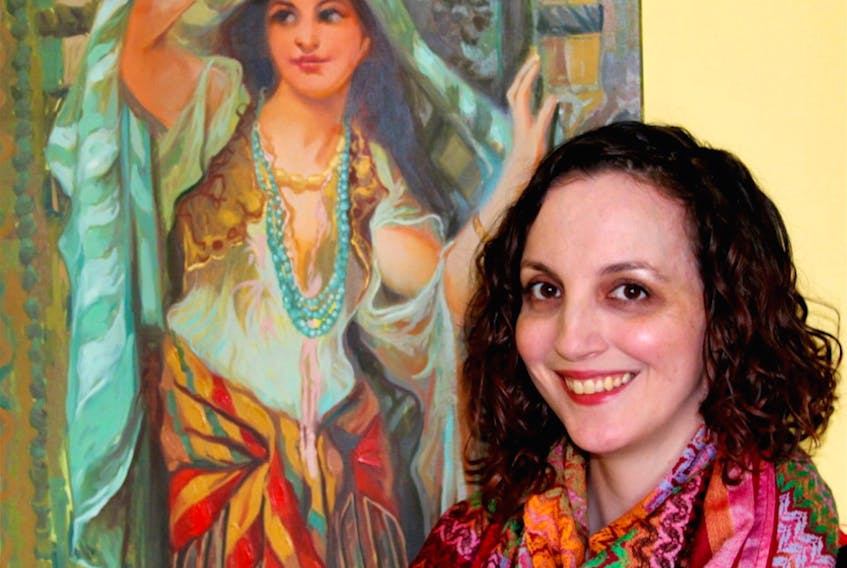Ainsley Hawthorn is unexpectedly re-writing a definition for the Oxford English Dictionary.
And the word she’s re-defining for the trusted glossary stems from the St. John’s scholar’s passion — belly dancing.
“I think it was a hobby turned passion for me,” she says.
How Hawthorne got to edit the definition of belly dance has more twists and turns than the traditional Middle Eastern dance.
Her love of Middle Eastern dance had begun in her childhood and travelled with her throughout her studies in Kingston and Yale, where she earned her Ph.D. in Near Eastern Languages and Civilizations. It was through encounters during her education that she came to realize the stereotypes about the dance she loved that are affecting Middle Eastern women.
She has a current research project that focuses on the language about Middle Eastern Dance and how the words we use influence how the dance is perceived.

“English speakers use ‘belly dance’ as a name for solo, improvised dances from the Middle East and North Africa that feature intricate movements of the torso, especially the shoulders, chests and hips,” Hawthorn said.
“The origins of the phrase, though, have been a mystery.”
Hawthorn spent an untold number of hours looking through hundreds of newspapers trying to find the origin of the term. It’s a mystery no more, Hawthorn believes.
She found a French painting from 1863 by Orientalist artist, Jean-Léon Gérôme, called “The Dance of the Almeh.” The painting was of an Almeh, a female entertainer in the Middle East, who was semi-nude in harem pants with her bare stomach pushed toward the viewer.
Hawthorn says the painting shows more of the Frenchman’s fantasy of Middle Eastern Dance, not an accurate representation of it.
The name belly dance actually came from the press reporting on the public outcry about the scandalous nature of Gerome’s painting. The press called what the Almeh was doing “La Danse du Ventre” or dance of the belly.
“If this really was the first time anyone used the name ‘belly dance’,” said Hawthorn, “It means the phrase was inspired by a European’s imagined idea of the Middle East, not by the movements of real Middle Eastern dance.”
She went on to explain that an Almeh would not have normally been seen semi-nude in public, like the painting shows.
“Actually, the high-class Almehs only danced in private for other women,” Hawthorn said.
She said this new information is significant because some find the name ‘belly dance’ reinforces negative stereotypes of Middle Eastern people as exotic or uncivilized.
Sobia Shaikh, assistant professor with Memorial University School of Social Work and co-lead of Addressing Islamophobia in NL project, says she doesn’t like the term but hadn’t thought much about it, so she’s glad someone did.
“I think it will change things. It will change the way we view language and it will allow us to think through more the racist and sexist stereotypes that are in place about Middle Eastern, Muslim and other racialized women,” Shaikh said. “So, I do think it is important.”
"...it will allow us to think through more the racist and sexist stereotypes that are in place about Middle Eastern, Muslim and other racialized women." — Sobia Shaikh
Hawthorn’s academic article, “Middle Eastern Dance and What We Call It”, is about her discovery. It is published by the Journal of Dance Research and became the most read article within less than two days.
One of the people who read her article was an editor for the Oxford English Dictionary, to whom she had already planned to send a correction about the term.
“He read my article and has asked for my help in improving the dictionary's definition of the term ‘belly dance’,” Hawthorn said.
Hawthorn also said she didn’t find one example in Middle Eastern history where they refer to the dance as “belly dance.”
“Now that we’ve learned the term wasn’t coined by Middle Easterners themselves, dancers can use that knowledge to decide whether they will continue using it,” she said.
“The idea that a women’s body is reduced to a belly, it is really disturbing,” Shaikh said.
“It would be like calling ballet, thigh dance,” Hawthorn said. “It just does not capture the skill it takes or the complexity of the dance. It simply narrows it down to a body part.”
Twitter: @JasmineBurtNL
MORE FROM JASMINE BURT









